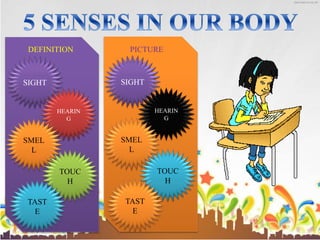
5 Senses by Shiela B. Ralleta
- 2. Sight. The eye is the organ of vision. It has a complex structure consisting of a transparent lens that focuses light on the retina. The retina is covered with two basic types of light- sensitive cells-rods and cones. The cone cells are sensitive to color and are located in the part of the retina called the fovea, where the light is focused by the lens. The rod cells are not sensitive to color, but have greater sensitivity to light than the cone cells. These cells are located around the fovea and are responsible for peripheral vision and night vision. The eye is connected to the brain through the optic nerve. The point of this connection is called the "blind spot" because it is insensitive to light. Experiments have shown that the back of the brain maps the visual input from the eyes The brain combines the input of our two eyes into a single three-dimensional image. In addition, even though the image on the retina is upside-down because of the focusing action of the lens, the brain compensates and provides the right-side-up perception. Experiments have been done with subjects fitted with prisms that invert the images. The subjects go through an initial period of great confusion, but subsequently they perceive the images as right side up.
- 3. Hearing. The ear is the organ of hearing. The outer ear protrudes away from the head and is shaped like a cup to direct sounds toward the tympanic membrane, which transmits vibrations to the inner ear through a series of small bones in the middle ear called the malleus, incus and stapes. The inner ear, or cochlea, is a spiral-shaped chamber covered internally by nerve fibers that react to the vibrations and transmit impulses to the brain via the auditory nerve. The brain combines the input of our two ears to determine the direction and distance of sounds. The inner ear has a vestibular system formed by three semicircular canals that are approximately at right angles to each other and which are responsible for the sense of balance and spatial orientation. The inner ear has chambers filled with a viscous fluid and small particles (otoliths) containing calcium carbonate. The movement of these particles over small hair cells in the inner ear sends signals to the brain that are interpreted as motion and acceleration. The human ear can perceive frequencies from 16 cycles per second, which is a very deep bass, to 28,000 cycles per second, which is a very high pitch. Bats and dolphins can detect frequencies higher than 100,000 cycles per second. The human ear can detect pitch changes as small as 3 hundredths of one percent of the original frequency in some frequency ranges. Some people have "perfect pitch", which is the ability to map a tone precisely on the musical scale without reference to an external standard. It is estimated that less than one in ten thousand people have perfect pitch, but speakers of tonal languages like Vietnamese and Mandarin show remarkably precise absolute pitch in reading out lists of words because pitch is an essential feature in conveying the meaning of words in tone languages.
- 4. Taste. The receptors for taste, called taste buds, are situated chiefly in the tongue, but they are also located in the roof of the mouth and near the pharynx. They are able to detect four basic tastes: salty, sweet, bitter, and sour. The tongue also can detect a sensation called "umami" from taste receptors sensitive to amino acids. Generally, the taste buds close to the tip of the tongue are sensitive to sweet tastes, whereas those in the back of the tongue are sensitive to bitter tastes. The taste buds on top and on the side of the tongue are sensitive to salty and sour tastes. At the base of each taste bud there is a nerve that sends the sensations to the brain. The sense of taste functions in coordination with the sense of smell. The number of taste buds varies substantially from individual to individual, but greater numbers increase sensitivity. Women, in general, have a greater number of taste buds than men. As in the case of color blindness, some people are insensitive to some tastes.
- 5. Smell The nose is the organ responsible for the sense of smell. The cavity of the nose is lined with mucous membranes that have smell receptors connected to the olfactory nerve. The smells themselves consist of vapors of various substances. The smell receptors interact with the molecules of these vapors and transmit the sensations to the brain. The nose also has a structure called the vomeronasal organ whose function has not been determined, but which is suspected of being sensitive to pheromones that influence the reproductive cycle. The smell receptors are sensitive to seven types of sensations that can be characterized as camphor, musk, flower, mint, ether, acrid, or putrid. The sense of smell is sometimes temporarily lost when a person has a cold. Dogs have a sense of smell that is many times more sensitive than man's.
- 6. Touch. The sense of touch is distributed throughout the body. Nerve endings in the skin and other parts of the body transmit sensations to the brain. Some parts of the body have a larger number of nerve endings and, therefore, are more sensitive. Four kinds of touch sensations can be identified: cold, heat, contact, and pain. Hairs on the skin magnify the sensitivity and act as an early warning system for the body. The fingertips and the sexual organs have the greatest concentration of nerve endings. The sexual organs have "erogenous zones" that when stimulated start a series of endocrine reactions and motor responses resulting in orgasm.